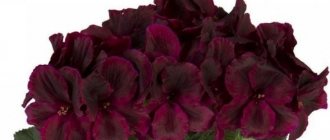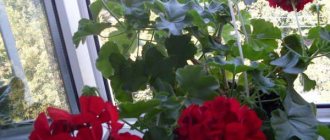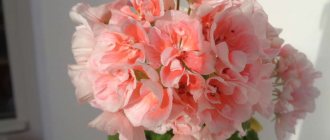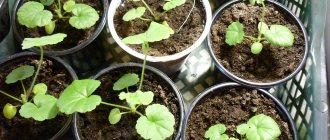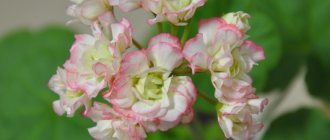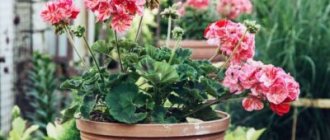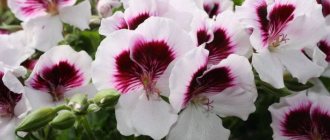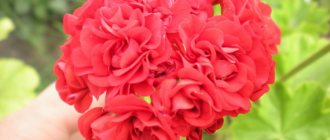Pelargonium upton
Colleagues, an earnest request to everyone! Please upload small photos to the forum (no more than 800 pixels on the wide side). We will be forced to delete large photos, for example, 2000x3000 pixels by default. BE SURE TO READ THE FORUM RULES!
Volunteer help is required in the greenhouses of the Main Botanical Garden of the Russian Academy of Sciences (Moscow, Botanicheskaya Street).
If you have the desire and time, then you can also help in this difficult matter.
Volunteers work in the garden on Mondays and one Sunday a month. Leader of the volunteer group in greenhouses: Evgeniy Gusev
. You can contact Evgeniy to clarify the time and place of the meeting on the next volunteer day. More details: https://vk.com/moscowtropics
Active participant
Group: Users Messages: 1341 Registration: 11/14/2013 From: Ekaterinburg User No.: 13372
Good evening, dear forum users! I, Lyudmila, live in Yekaterinburg. Wonderful, beautiful, my beloved city, which turns 293 years old tomorrow!
Well, after almost 3 years of being on our forum, I decided to open my own page. Oh, and for a long time I doubted whether I needed all this or not. And then I thought - why not? In the end, whoever likes it will come to visit me, and someone, perhaps, will pass by)) And I have accumulated a few photographs for this season, I want to show it, but I can’t look at them alone . And Friday evening, and a free evening, when you don’t have to rush or go anywhere, but you can calmly sit down at the computer, collect all your thoughts in your head melted from the heat into one pile, and chat with you, so far from me, but so already became close people. What turned out to be the most interesting and difficult for me was coming up with a name for my topic. I don’t know how anyone chooses a name for their page, but I struggled for a long time, to be honest)) It got to the point of being funny. That’s all, it seems, I came up with a suitable name, but as soon as you start leafing through the lists of topics, it turns out that the same or similar names already exist. And in order not to offend anyone and not engage in plagiarism, I decided to name my topic as I called it. Simple and unpretentious. Well, okay. So that’s what it should be called – “Pelargonium at Lyudmila’s”.
So, I start quietly, without rushing.
My pelargoniums. I select them first of all for the soul, then to decorate the area of a country house, and I leave quite a few pelargoniums at home on the windows and on the balcony. And I don’t seem to have that many varieties, but for some reason I get almost twice as many pots. I keep some of my favorite varieties in duplicates. Like, for example, this variety, from which I open my first page.
Ainsdale Duke. I currently have four plants of this variety.
Gorgeous variety! At the dacha it simply cannot be replaced; it is visible from all corners of the garden. It burns and shines in the sun. The second year is my favorite and an indispensable assistant in decorating the site.
Active participant
Group: Users Messages: 4777 Registration: 1/14/2010 From: Kazan User No.: 6053
Luda!
Congratulations on such a bright opening of your page!
Beauty. And I chose the variety - it hit me right in the heart!))) It’s like some kind of hymn to pelargonium)))! And Letu-Red!!
I always looked into your regional branch with great pleasure; I noticed a long time ago, well, literally thematic photographs of your plants! I am very happy when pages like this open! Thank you for the aesthetic pleasure! What will happen next? :)))
Well done. And I picked up pots and pots! I remember how you set your sights on them - buy little by little :)) Well, with this direction of the topic, move forward. Once upon a time there were flowers at Lyudmila))))) Smart girl. And the photographs are wonderful.
Pelargonium upton
LENApelarg writes: Tanyush, your Larochka is incomparable. Is she an ivy-live hybrid, or does she look more like a zonal plant in the shape of a bush?
Len, Lara Harmony, in my opinion, is a purebred Zonalka. Not a dwarf, but not up to standard either. It’s forming well for me, it took root wonderfully in the spring, now it’s “getting on my nerves,” but how good it is, lousy! On the south window it effortlessly holds two huge full-fledged inflorescences. One thing I don’t like is that the inflorescences do not have a clearly defined shape – not like a ball, but I really like balls!
Gala writes: I didn’t pay attention to pelargonium before, but last fall it was as if my eyes were opened and this is the result, my first little angel
You might even faint from such a miracle! The most gorgeous plant! Thank you very much for the moments of aesthetic pleasure.
Home care
Let's look at the basic recommendations for caring for this miniature plant.
Watering
This plant must be provided with moisture regularly and in sufficient quantity. In summer, it is better to water every other day, and in winter, the number of waterings should be reduced to once a week. It is not recommended to allow excessive moisture: the soil should be dry before the next watering.
Carefully loosen the soil after each watering, since regular and sufficient oxygen access to the roots is very important for dwarf pelargonium.
Dwarf pelargonium does not need spraying: this procedure can only damage its foliage and flowers.
Top dressing
The plant needs regular additional nutrition throughout the growing season from March-April to October-November. In winter, dwarf pelargonium is not fed, giving it time to rest.
The plant especially needs phosphorus and potassium, but you need to be careful with nitrogen: with an excess of this microelement, the green mass of dwarf pelargonium actively grows, but the flowers are in no hurry to form.
Advice! It is recommended to use complex fertilizer for pelargoniums: all components in this composition are selected in the best and most optimal way. The frequency of fertilization is once every couple of weeks.
Collection of pelargoniums by Elena Kuzmina
Flower passion.
Zonal pelargonium Norrland
I love all living plants. I see a highlight in each of them. But my strongest flower passion in recent years has been pelargoniums.
Dear readers, at the moment I have a small but amazingly beautiful collection of unusually blooming pelargoniums. I have “Rosebud” - pelargoniums blooming with roses, Tulip - blooming with tulips, asters, carnations, one variety - peonies. There are several fragrant varieties, with the scent of rose, lemon, wormwood, peach, and apple. And I want to share all this wealth with you.
Terms of sale of pelargoniums 2022
Pelargonium exhibition, indoor floriculture club “Violet”, Smolensk 2016
I sell cuttings rooted in 100g cups
Sales all year round, subject to delivery by a transport company, by bus, I arrange it myself. To the order amount you need to add approximately 400 rubles for transportation and packaging. I don’t send pelargoniums by mail because they don’t arrive well, then they get sick for a long time and, as a rule, they don’t survive.
My email address e
Viber and WhatsApp tel.
1. Pelargoniums of the Rosebud series and Rosaceae
Apple Blossom Rosebud Price 200 rub.
Apple Blossom Rosebud Price 200 rub.
Apple Blossom Rosebud is a rosaceous zonal pelargonium. The plant is very large and fast growing. It requires the initial formation of the bush, and then it will show all the beauty and harmony of flowering. Loves very “fat” soil. Last year I fed them with liquid fertilizers for the flowering ones, but this year I just planted them in “humus” in the spring. The variety blooms very profusely, begins early in the spring and, probably, if not pruned in the fall, will bloom into the winter. This photo is fresh from autumn, I published it only because of its good quality, it does not reflect the true beauty of the variety. In summer the hats are much larger and denser. I especially admire roses - large white ones with a green center and pink edging of delicate petals.
Landing rules
Let's get acquainted with the basic rules regarding planting dwarf pelargonium.
Lighting and location selection
Important! In order for dwarf pelargonium to bloom beautifully and for a long time, it needs to grow in a well-lit place. With enough sunlight, the plant's petals are brighter and greener. If pelargonium experiences a lack of light, its decorative effect will fade: there will be fewer inflorescences and the leaves will turn pale.
However, the plant does not tolerate direct rays: at midday, therefore, it is recommended to shade pelargonium. In winter, so that the flower does not lose its decorative effect, it needs to be provided with additional artificial lighting.
In order for the crown of the plant to form compactly, it is recommended to periodically turn the pot towards the window with different sides. This way, the sun's rays will be able to reach all parts of the plant, and the pelargonium will stretch evenly.
Temperature
In summer, pelargonium should be kept in moderate temperatures: +17+23 degrees will be ideal. The plant should not be allowed to overheat. It is better for a flower to overwinter at a temperature of +12-13 degrees, not higher, since at this time the plant should slow down all its vegetative processes and rest.
The soil
Note that dwarf pelargonium is not too demanding on the composition of the soil. The main thing in this case is to provide the plant with good drainage so that the moisture in the pot does not stagnate.
Soils with a neutral or slightly alkaline reaction are best suited for the plant. If the soil is acidic, it is recommended to neutralize it with ash. The recommended substrate composition is as follows:
- part of the humus;
- part of the leaf soil;
- part of the turf;
- part of the river sand.
Pelargonium zonal: the best varieties with descriptions
For almost a century, breeders all over the world have been breeding new varieties of pelargonium. Thanks to their efforts, an incredibly large number of different varieties and varieties of this ornamental plant were obtained. The culture is not overly demanding in terms of growing conditions and, with proper care, will definitely respond with lush, luxurious flowering. We bring to your attention detailed information about zonal pelargonium, as well as its best varieties (photos with names and descriptions are attached).
Diseases and pests
Let's find out what diseases and harmful insect parasites can threaten this plant.
So, the most dangerous pests are aphids, spider mites and whiteflies. Special formulations with fungicides can cope with these harmful insects.
Dwarf pelargonium is susceptible to a disease called “black leg”. This is root rot that affects the plant as a result of excessive soil moisture and insufficiently high air temperatures. Note that blackleg cannot be treated: the diseased plant must be disposed of. The soil remaining in the pot after disposal of the plant can no longer be used in floriculture: it must also be disposed of.
Excessive watering can also lead to swelling on the leaves and their rotting. And too low a temperature can lead to reddening of the foliage. To prevent this from happening, on frosty, cold days, move the pot away from the window glass.
With a lack of light, the stems of the plant stretch out and become bare. Solving this problem is simple: you just need to place the pot of pelargonium in its proper well-lit place. If the plant does not bloom, the reason for this may be that the air temperature is too high when the plant overwinters.
Basic classification of zonal pelargonium
Zonal pelargoniums, in turn, can be divided into several subgroups:
- Rosaceae. All varieties presented in this category have luxurious double flowers that look very reminiscent of classic roses.
- Tulip-shaped. The flowers of varieties from this group are small flowers collected in inflorescences. Outwardly they resemble small unopened tulip-shaped buds. The petals of tulip-shaped pelargoniums have a rather unusual appearance: they are slightly inclined inward and lowered, as if they have already begun to fade. This in no way means that the plants are actually withering. In fact, the sluggish appearance of the petals is a specific feature of the variety.
- Star-shaped. Star pelargoniums are completely different from their “compatriots”: the flowers of these dwarf plants have an unusual shape of a pointed star. Moreover, quite often the two largest petals have an elongated shape with a sharp end, which makes them different from the rest.
- Dianthus. The varieties presented in this category are very similar in appearance to garden carnations: they are just as large, with carved petals of a fairly bright shade.
- Cactus-like. A rather rare variety of zonal pelargonium, which is represented by a fairly large, heavily leafy bush. The leaves are wide, bright green. Flowers of cactus-shaped varieties look quite unusual: their petals seem to be rolled into narrow tubes. Quite often they have a slightly “disheveled” appearance.
- Deacons. Quite young hybrids that appeared on the world flower market less than 50 years ago. They are presented as a very compact, abundantly flowering bush with a small rosette of flowers in a soft peach, pink or red hue.
Let's take a closer look at several of the best representatives in each category of zonal varieties of pelargonium. Among the most popular rose-colored varieties are several:
- April Snow is a neat dwarf plant with small double pink flowers in the form of roses.
- Denise is a powerful plant that every year is covered with a large terry cap of pink or peach color.
- Monseruds Rosen is not easy to grow - it is quite difficult to form the required shape, it is distinguished by luxurious burgundy flowering.
Among the most popular star varieties of pelargonium are the following:
- Aunty Pam – Stellar. The variety is represented by a fairly compact, well-branched bush, densely covered with luxurious bright pink flower rosettes. Externally, the flower petals resemble a small terry carnation.
- Borthwood – Stellar. Another excellent star variety, this is a heavily flowering dwarf shrub whose leaves are shaped slightly like frogs' legs.
- Fandango. A rather unusual variety, the flowers of which look slightly “shabby”: the shape of the petals is a little torn, with fuzzy edges. The plants bloom abundantly and lushly; the flowers have a pleasant soft coral hue.
Among the cactus-like varieties of pelargonium, the following can be noted:
- Fascination (the petals of the plant are quite long, with edges bent down, which makes their appearance very extravagant, somewhat reminiscent of human nails);
- Noel (the petals of the plant’s flowers have a delicate white color and a twisted shape, with a pinkish anther rising in the center).
This concludes our acquaintance with one of the varieties of such an unusual and pleasant plant to grow as zonal pelargonium. Good luck!
Flower bed design. TOP 10 simple and effective techniques
Reproduction
Note that the bush is able to maintain its decorative effect for two to five years, after which it is recommended to replace it with a more recent specimen. A full-fledged plant from a cutting will grow in about a year - so take care of the “growing replacement” in advance.
The plant propagates by cuttings. To carry out this procedure correctly, it is recommended to cut the cuttings in February-March: use the apical part of the mother plant.
Advice: take cuttings from the most powerful and healthy bushes: their offspring will be the most life-loving. The size of the cut cuttings should be approximately 2.5-3 cm.
Then the cut must be dried for several minutes and, without immersing it in water, immediately planted in prepared loose nutritious soil. Do not cover the top with anything, so as not to create a greenhouse effect and not to over-water the plant. The container must be placed in a sunny, bright place - and in about a month you will already have young dwarf pelargonium. Cuttings root best at a temperature of +20+22 degrees and with regular watering
After the flower has taken root and 8-10 leaves have formed on it, the first pinching is carried out. The procedure will help the plant grow in breadth and become compact. The next pinchings are carried out on the side shoots, when, in turn, they will have 8-10 leaves. And, although cuttings planted in the spring can bloom in the same summer, in the first year experienced gardeners recommend directing all efforts to forming a proper compact bush - and then the next year the flowering will be simply amazing.
Pelargonium should not be propagated in winter, since at this time the plant is in hibernation, all processes in it are inactive, and the cutting may not take root at all.
Our experts have prepared for you a number of other articles with photos and descriptions, as well as information on the nuances of growing and caring for ampelous, fragrant, variegated, ivy-leaved, tulip-shaped, terry, rosebud and zonal pelargonium.
So, dwarf pelargonium can become a real decoration for any apartment, including a small one - after all, the plant itself is very compact. Care for pelargonium with love and responsibility - and it will often delight you with its spectacular decorative flowering.
If you find an error, please select a piece of text and press Ctrl+Enter.
Dwarf pelargonium is a compact and graceful plant that has gained popularity due to its abundant flowering, richness of colors and relative unpretentiousness. Let's learn more about this type of geranium and get acquainted with the most interesting dwarf varieties.

